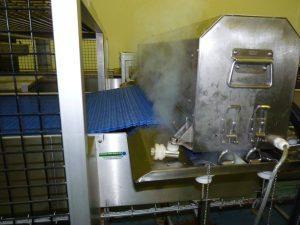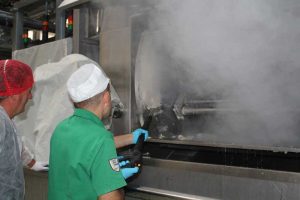Efficient conveyor belt cleaning is essential for maintaining high levels of productivity in industrial settings. When conveyor belts are clean and free from debris, materials can flow smoothly and efficiently along the production line. This results in faster processing times and increased output.
In addition to improving production efficiency, efficient conveyor belt cleaning can also reduce downtime. When belts are regularly cleaned and maintained, there is less chance of unexpected breakdowns or malfunctions. This means that production can continue uninterrupted, minimizing costly downtime.
Moreover, efficient conveyor belt cleaning can also help reduce maintenance costs. When belts are kept clean and free from debris, there is less wear and tear on the equipment. This means that belts and other components will last longer, reducing the need for frequent replacements or repairs. By investing in regular cleaning, businesses can save money in the long run by extending the lifespan of their conveyor systems.
The Cost of Conveyor Belt Cleaning: Balancing Expense with Benefits
While conveyor belt cleaning is crucial for maintaining productivity and safety, it is essential to consider the costs associated with this maintenance task. Depending on the size and complexity of the conveyor system, cleaning can require significant time, effort, and resources.
The costs of conveyor belt cleaning can include labor expenses, as workers need to be allocated to perform the cleaning tasks. Additionally, there may be costs associated with purchasing cleaning equipment and supplies, such as brushes, detergents, or steam vapour cleaning machines. Furthermore, if external cleaning services are hired, there will be additional costs involved.
However, it is important to balance these expenses with the benefits of efficient conveyor belt cleaning. As discussed earlier, clean belts can improve production efficiency, reduce downtime, and lower maintenance costs. Therefore, while there may be upfront costs associated with cleaning, the long-term benefits can outweigh these expenses.
Businesses should consider the potential return on investment when deciding on their conveyor belt cleaning strategy. By investing in regular and efficient cleaning methods, they can expect increased productivity, reduced downtime, and lower maintenance costs in the long run.
The Role of Steam Vapour Cleaning Machines in Conveyor Belt Cleaning
Steam vapour cleaning machines have emerged as a popular and effective method for conveyor belt cleaning. These machines use high-temperature steam to remove dirt, grease, and other contaminants from the belts without the need for harsh chemicals or excessive water usage.
Steam vapour cleaning machines offer several advantages for conveyor belt cleaning. Firstly, they provide a deep and thorough clean by penetrating into the pores of the belt material and loosening dirt and debris. This ensures that the belts are not only visually clean but also free from hidden contaminants that can affect production and safety.
Secondly, steam vapour cleaning machines are environmentally friendly. They use minimal water compared to traditional cleaning methods, reducing water consumption and wastewater generation. Additionally, they do not require the use of harsh chemicals, making them a safer and more sustainable option for conveyor belt cleaning.
Furthermore, steam vapour cleaning machines are versatile and can be used for various cleaning tasks in addition to conveyor belts. They can be used to clean other equipment, surfaces, and even remove graffiti or sanitize areas. This makes them a valuable investment for businesses looking to improve overall cleanliness and hygiene in their facilities.
How Steam Vapour Cleaning Machines Work: An Overview
| Metrics | Results |
|---|---|
| Reduction in water usage | Up to 90% |
| Reduction in chemical usage | Up to 95% |
| Elimination of bacteria and viruses | 99.9% |
| Reduction in cleaning time | Up to 50% |
| Improved hygiene and safety | Yes |
Steam vapour cleaning machines work by heating water to high temperatures, typically above 100 degrees Celsius, to produce steam. This steam is then directed onto the conveyor belts using a nozzle or brush attachment. The high temperature of the steam helps to break down dirt, grease, and other contaminants, making them easier to remove.
The steam vapour penetrates into the pores of the belt material, loosening any trapped debris. The pressure from the steam also helps to dislodge stubborn stains or build-up. Once the contaminants have been loosened, they can be wiped away or vacuumed up using the machine’s built-in vacuum function.
One of the key benefits of steam vapour cleaning machines is their ability to sanitize surfaces. The high temperature of the steam kills bacteria, viruses, and other pathogens, making it an effective method for maintaining cleanliness and hygiene in industrial settings.
Benefits of Using Steam Vapour Cleaning Machines for Conveyor Belt Cleaning
Using steam vapour cleaning machines for conveyor belt cleaning offers several benefits. Firstly, they provide a deep and thorough clean that removes dirt, grease, and other contaminants from the belts. This ensures that the belts are not only visually clean but also free from hidden contaminants that can affect production and safety.
Secondly, steam vapour cleaning machines are a cost-effective option for conveyor belt cleaning. They use minimal water compared to traditional cleaning methods, reducing water consumption and wastewater generation. Additionally, they do not require the use of harsh chemicals, eliminating the need to purchase and store cleaning agents. This can result in significant cost savings over time.
Furthermore, steam vapour cleaning machines are efficient and time-saving. The high temperature of the steam helps to break down dirt and debris quickly, reducing the time required for cleaning. Additionally, the built-in vacuum function allows for easy removal of loosened contaminants, further speeding up the process.
Moreover, steam vapour cleaning machines offer a safe and environmentally friendly cleaning solution. They do not produce harmful fumes or residues, making them safe for workers and the environment. Additionally, they can help businesses reduce their carbon footprint by minimizing water usage and chemical waste.
Types of Steam Vapour Cleaning Machines for Conveyor Belts

There are several types of steam vapour cleaning machines available for conveyor belt cleaning. The most common types include handheld steam cleaners, steam mops, and industrial-grade steam vapour cleaners.
Handheld steam cleaners are compact and portable devices that are suitable for small-scale cleaning tasks. They are lightweight and easy to maneuver, making them ideal for spot cleaning or reaching tight spaces on conveyor belts. However, they may not be suitable for larger or more heavily soiled belts.
Steam mops are larger devices that resemble traditional mops but use steam instead of water and detergent. They are designed for larger surface areas and can be used on conveyor belts with moderate levels of dirt or debris. Steam mops typically have a larger water tank capacity and longer operating times compared to handheld steam cleaners.
Industrial-grade steam vapour cleaners are heavy-duty machines specifically designed for commercial and industrial cleaning tasks. They are more powerful and have a higher steam temperature and pressure compared to handheld steam cleaners or steam mops. These machines are suitable for large-scale conveyor belt cleaning and can effectively remove stubborn stains or build-up.
When choosing a steam vapour cleaning machine for conveyor belt cleaning, businesses should consider factors such as the size and complexity of their conveyor system, the level of dirt or debris present, and their budget. It is important to select a machine that is suitable for the specific cleaning requirements to ensure optimal results.
Automatic Conveyor Belt Steam Vacuum: A Game Changer in Cleaning Efficiency
Automatic conveyor belt steam vacuums are a game changer in cleaning efficiency. These machines combine the power of steam vapour cleaning with a built-in vacuum function, allowing for simultaneous cleaning and debris removal.
The automatic conveyor belt steam vacuum works by directing high-temperature steam onto the belts to loosen dirt and debris. The built-in vacuum then immediately sucks up the loosened contaminants, leaving the belts clean and dry. This eliminates the need for manual wiping or additional drying time, significantly reducing the overall cleaning time.
The combination of steam vapour cleaning and vacuuming also ensures a more thorough clean. The vacuum function removes not only the loosened dirt but also any excess moisture, preventing the formation of mold or mildew on the belts. This helps to maintain optimal hygiene and prolong the lifespan of the belts.
Furthermore, automatic conveyor belt steam vacuums are highly efficient and cost-effective. The simultaneous cleaning and debris removal process saves time and labor costs. Additionally, the reduced drying time eliminates the need for additional equipment or resources, further reducing expenses.
Factors to Consider When Choosing a Conveyor Belt Cleaning Method
When choosing a conveyor belt cleaning method, there are several factors that businesses should consider. These factors can help determine the most suitable cleaning method for their specific needs and ensure optimal results.
Firstly, the level of dirt or debris present on the belts should be assessed. If the belts are heavily soiled or have stubborn stains or build-up, a more powerful cleaning method, such as steam vapour cleaning, may be required. On the other hand, if the belts are only lightly soiled, a less intensive method, such as manual wiping or using a steam mop, may be sufficient.
Secondly, the size and complexity of the conveyor system should be taken into account. For larger systems with multiple belts or complex configurations, a more efficient and time-saving method, such as an automatic conveyor belt steam vacuum, may be necessary. Smaller systems may be adequately cleaned using handheld steam cleaners or other manual methods.
Additionally, the frequency of cleaning should also be considered. If the belts need to be cleaned frequently due to high levels of dirt or debris, a method that is quick and easy to use, such as a steam mop or handheld steam cleaner, may be more suitable. However, if cleaning is only required periodically, a more intensive method, such as steam vapour cleaning or an automatic conveyor belt steam vacuum, may be more cost-effective in the long run.
Lastly, businesses should also consider their budget when choosing a conveyor belt cleaning method. While more advanced methods, such as steam vapour cleaning or automatic conveyor belt steam vacuums, may have higher upfront costs, they can provide significant long-term savings through increased efficiency and reduced maintenance expenses. It is important to weigh the initial investment against the potential benefits and savings over time.
Finding the Right Balance between Efficiency and Expense in Conveyor Belt Cleaning
In conclusion, efficient conveyor belt cleaning is crucial for maintaining productivity and safety in industrial settings. Dirty belts can lead to decreased production efficiency and increased downtime. Neglecting conveyor belt cleaning can also pose safety risks for workers.
Steam vapour cleaning machines offer an effective and environmentally friendly solution for conveyor belt cleaning. They provide a deep and thorough clean, improve efficiency, and reduce costs. There are various types of steam vapour cleaning machines available, including handheld steam cleaners, steam mops, and industrial-grade steam vapour cleaners.
When choosing a conveyor belt cleaning method, businesses should consider factors such as the level of dirt or debris present, the size and complexity of the conveyor system, the frequency of cleaning required, and their budget. By finding the right balance between efficiency and expense, businesses can ensure optimal results and long-term cost savings.
FAQs
What is a cost-benefit analysis?
A cost-benefit analysis is a process of evaluating the costs and benefits of a project or decision in order to determine its feasibility and potential profitability.
What is a conveyor belt cleaning system?
A conveyor belt cleaning system is a device or set of devices used to clean conveyor belts in order to maintain their efficiency and prevent contamination of products being transported.
What are the benefits of implementing a conveyor belt cleaning system?
Implementing a conveyor belt cleaning system can lead to increased efficiency, reduced downtime, improved product quality, and decreased risk of contamination.
What are the costs associated with implementing a conveyor belt cleaning system?
The costs associated with implementing a conveyor belt cleaning system can include the cost of the system itself, installation costs, maintenance costs, and training costs.
How is a cost-benefit analysis conducted for a conveyor belt cleaning system?
A cost-benefit analysis for a conveyor belt cleaning system involves identifying and quantifying the costs and benefits associated with the system, and then comparing them to determine whether the benefits outweigh the costs.
What factors should be considered in a cost-benefit analysis of a conveyor belt cleaning system?
Factors that should be considered in a cost-benefit analysis of a conveyor belt cleaning system include the cost of the system, the potential increase in efficiency, the potential reduction in downtime, the potential improvement in product quality, and the potential decrease in risk of contamination.










